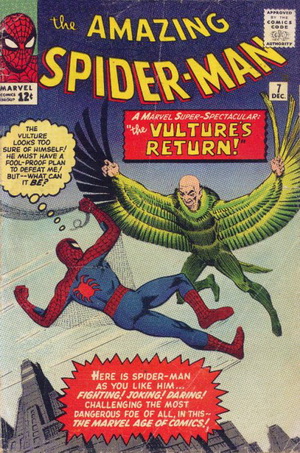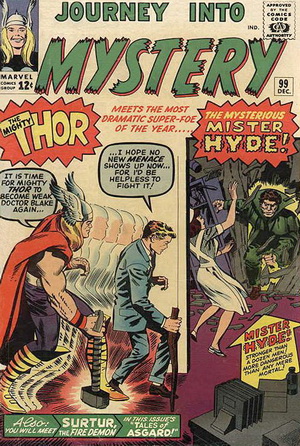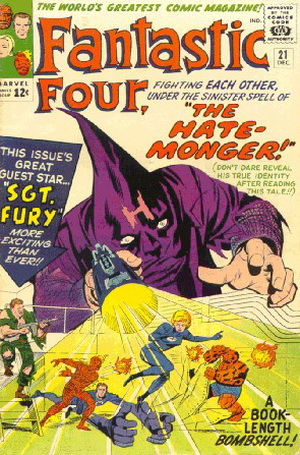AMAZING SPIDER-MAN #7
 “The Return of the Vulture”
“The Return of the Vulture”
Script: Stan Lee
Art: Steve Ditko
Letters: Art Simek
IN A NUTSHELL:
The Vulture escapes from prison and when Spider-Man zaps him with his anti-magnetic inverter, this time it doesn’t work! His arm injured in the scuffle, Spidey still attempts to tackle the Vulture when the winged weirdo comes to Jameson’s office to steal the payroll.
The Vulture drags Spider-Man high into the sky, planning to drop him, but Spider-Man saves both of them with a webbed parachute. Back on earth, Peter puts the moves on Betty Brant.
WHAT’S HOT
FRUSTRATION. Peter admits, “The worst thing about being Spider-Man is changing clothes a zillion times a day!” And doing it with a bum arm doesn’t make it any easier! Yet another example of how poor Spider-Man has to deal with the aggravations of Real Life.
TEMPER. A couple of times in this story, Peter makes reference to how much self-control he’s got to exert to keep himself from hauling off and pulverizing Flash, who keeps picking on him. He’s a time bomb about to explode! Suspense!
ROMANCE. Peter’s been thinking about Betty for several issues now, and on the last page of this story we’ve got some serious flirting on both sides. She says she likes him, and he calls her “Baby.” Oooo-la-la! This could be the start of something!
WHAT’S NOT
HYPERBOLE. The cover assures us that Spider-Man will challenge “the most dangerous foe of all.” Is that the Vulture they’re talking about? MOST dangerous? On page one, Stan tones it down a bit to describe the Vulture as ONE OF the most dangerous villains of all time. Is that really fair?
CASH. Okay, I know the 1960’s are not as technologically advanced as we are today, but paychecks had been invented, right? We don’t really need to pay hundreds of employees in cash, do we?
CASH FLOW. Jameson pleads with the Vulture not to take the payroll from the vault, saying it’s all he’s got. Either, as the publisher of NYC’s biggest newspaper and magazine, he’s the worst money manager on the face of the earth, or…he’s a bold-faced liar.

JOURNEY INTO MYSTERY #99
 “The Mysterious Mister Hyde!”
“The Mysterious Mister Hyde!”
Script: Stan Lee
Art: Don Heck
Letters: Art Simek
IN A NUTSHELL
While Thor again pleads with Odin for permission to marry Jane Foster, the evil Mr. Hyde breaks into Don Blake’s office, seeking vengeance after Blake refuses to hire him. Blake returns in time to confront Hyde but is pushed out the window. Transforming to Thor, he survives the fall, which further infuriates Hyde, who now focuses his attention on that meddlesome Thor, by impersonating the Thunder God and robbing a bank. As this issue ends, the police are on the lookout for the criminal Thor…
WHAT’S HOT
WOMEN’S INTUITION. Jane may have confused feelings for Don Blake, but she hits the nail on the head when she muses, “I feel he loves me too…but there seems to be some terrible secret which he never dares to speak of…but which will eternally keep us apart!”
ASSETS. When Zabo lists the reasons why he hates Dr. Blake, first is wealth, then fame. And what’s next? A beautiful nurse! Well, that’s the deal-breaker, right there. Gotta hate a guy who has a beautiful nurse.
PERFECT ALIBI. Even Zabo’s fingerprints change when he becomes the monstrous Mr. Hyde, making him an even more powerful villain, for as he notes, this is “the perfect means of escape.”
IMMORTALITY. Here we learn for the first time that Thor possesses, among all his other powers, the ability to transform a human into an immortal. Whoa! Are you kidding me?? Stop the bus! And Odin does, immediately reciting a long list of positive attributes the human must exhibit before such a transformation is possible. Thor joyously clings to the hope that he may yet get to visit this immortality upon his love, Jane Foster. Jane’s a very nice girl, the kind any fellow would love to take home to meet mother, and I don’t want to throw cold water on Thor’s expectations, but somehow I doubt she’s going to pass Odin’s strict litmus test. At least not for a long time.
TO BE CONTINUED…What’s this? No resolution? Is Thor really robbing banks now? Well, even though it’s not explained in this issue, I think we can feel reasonably sure that Hyde is impersonating Thor to damage his reputation. That’s not the mystery. The mystery is “How is this all going to turn out?” Finally, the title of this book, JOURNEY INTO MYSTERY, has some meaning!
WHAT’S NOT
LAME. When Calvin Zabo first visits Dr. Blake, he describes him as “the famous lame doctor.” Why can’t he just be famous for being a doctor? Do we really need to include the “lame” factor in that description? That particular morsel of excessive detail strikes me as a bit…lame…
FAMILY SQUABBLE. Yes, Thor and Odin get into it, to the point that Thor raises his hand to his father, to which Odin responds with a sudden zap of some sort of energy beam. When Gods Quarrel: this is intense stuff!
SEXISM!! Upon seeing Blake falling from the window, Jane conveniently faints. I understand we have to get her out of the way for a few moments, but the explanation of “And then, because she IS a female,” just reeks of 1960’s sexism. Really? Oh, please…
JEKYLL AND HYDE
Stan pays homage to the classic Dr. Jekyll and Mr. Hyde by Robert Louis Stevenson, and just in case you’re not familiar with the source, author and title are provided on the top of page five. Much appropriate, for how many Marvel heroes and villains owe a debt to Mr. Stevenson’s classic tale?
When our Marvel heroes take potions or get zapped by rays, their heroic natures and attributes become only moreso (Fantastic Four, Henry Pym, Peter Parker, and arguably, Bruce Banner). Likewise, when Marvel villains undergo the same, their natures also become intensified (Dr. Octopus, Lizard, Sandman and Cobra).
When Calvin Zabo concocts his potion, it is with the hope of changing a human being SO THAT his “base nature” takes over. Correct me if I’m wrong, but in the original story, I think that was an unfortunate outcome, not Dr. Jekyll’s original intention.

FANTASTIC FOUR #21
 “The Hate-Monger!”
“The Hate-Monger!”
Script: Stan Lee
Pencils: Jack Kirby
Inks: George Bell
Letters: Art Simek
IN A NUTSHELL
The FF squabble, after being zapped by the Hate-Monger’s H-Ray. Reed helps Nick Fury quell a South American revolution. Annoyed that Reed went on a solo mission, the others follow, as does the Hate-Monger. When Reed discovers the Hate-Ray machine, the villain explains his evil plan, just before Fury bursts in to save his pal. The Hate-Monger is forced to give the antidote to Reed, and the other FF members are tricked into taking it as well. When the Hate-Monger is killed by his own men, he is unmasked, and revealed as… Adolf Hitler!
WHAT’S HOT
THOUGHT-PROVOKING. The splash advertises this as a tale that is “most unusual and thought-provoking.” Recently, in my review of the Dr. Strange origin story, I mentioned that Marvel is moving away from tales aimed at little boys. The promise of “thought-provoking,” along with themes of racial prejudice, clearly addresses an older audience.
NICK FURY. The last time I saw Fury was in the premiere issue of Sgt. Fury and His Howling Commandos. Not much for war stories, I haven’t read any more, but it’s good to see him teaming up with the FF to fight evil. Regardless of the fact that I like my Nick Fury to look like Samuel L. Jackson and wear an eye patch, it’s still cool to see this crossover.
SURPRISE! On the cover, we are warned there will be a surprise ending, and the unmasking of the villain on page 22 does not disappoint.
BRUNETTE. Early in the story, Sue tries on a black wig. What’s this all about? Simple girly fun, as the narrator suggests, or were Stan and Jack trying to gauge if their older audience might prefer her as a brunette?

WHAT’S NOT
CAPTAIN OF THE OBVIOUS, PART 1. How likely is it that a leader who unashamedly calls himself the HATE-Monger could rise to power? Who would openly follow someone like that? Of course, once you’ve been zapped by the H-ray, you’ll follow him, no questions asked. But who’s going to get anywhere near a maniac called “The Hate-Monger”?
CAPTAIN OF THE OBVIOUS, PART 2. The Hate-Monger wears a giant yellow H on his costume. I understand why he would hide his face under a KKK-esque pointed hood, but how can we take him seriously with that giant yellow H on his chest? Of course, Superman wears a giant S on his chest, and there’s some yellow in it, but his design is mostly patriotic red and blue. Yellow reminds me of…oh, I don’t know, BIG BIRD. And why do we need an H at all? Is it like…in case you don’t know who I am when you see me showing up in my purple pointed face mask, this big yellow H should leave no doubt?
STUPID CRIMINAL MISTAKES. The Hate-Monger makes the fatal mistake of gloatingly telling his rival all his deepest secrets, just before planning to kill him. Of course when your rival is super-scientist Reed Richards and his pals are Nick Fury and the other members of the FF, it’s probably best not to waste any time, if you don’t want your diabolical plans getting all mucked up.
ANTIDOTE? The Hate-Monger says only he shall remain impervious to the H-Ray, for only he possess the antidote. Uh, correct me if I’m wrong, but if someone wants to cause everyone in the world to hate everyone else in the world, is this a guy that really NEEDS to be impervious to the Hate Ray? Isn’t he pretty hateful already?
C.I…WHO?? Fury says the C.I.A. knew all about the Hate-Monger and what he was doing, but “couldn’t interfere in another nation’s affairs.” Oh really? Isn’t the whole purpose of the C.I.A. to interfere with other nation’s affairs? Was this not the case in 1963? Or did the writers simply not know?
IRONY, PART 1. When the Hate-Monger travels underground in his sub-surface missile, the editor informs us that the Russians are currently working on a similar vehicle. Why are we told this? What purpose does this information serve except to make us want to swear, “Those lousy Russians!!” In a story that paints prejudice in such a negative light, obviously inferring that it’s just plain wrong to engage in “class hatred, race hatred, religious hatred,” it seems that political hatred of the Russians is perfectly acceptable.
IRONY, PART 2. There have been rumors for years that Adolf Hitler did not actually die when history says he did, and in this story, Reed speculates that it may have been one of Hitler’s many doubles that died in his place. Of course, that brings up the question: if it was a double who died in Hitler’s place, then who is the Hate Monger…really? Hitler…or just another double? And is the real Adolf Hitler still out there?
















Chrissy,
Some fun stories here, particularly Spider-Man. This one one of the earliest issues of the Lee-Ditko story I read at six years old in Marvel Tales, which was then beginning to reprint the early issues. I was immediately hooked. There was enough action and suspense to hold my attention, and in later years I enjoyed all the extra touches, particularly the ending with Betty and Peter. Unlike DC, the characters could grow and develop, and there was a sense of reality about the scene.
Some other touches that remain with me: Lee’s line by Spider-Man to the Vulture: “Are you sure you were never vaccinated with a phonograph needle?” and JJ bickering with the Vulture, which reminded me of a famous Jack Benny bit where the penny pitcher is accosted by a criminal who demands “Your money or your life!” to which Benny replies: “I’m thinking about it!”
And in answer to your question about JJ, yes, he was lying through his teeth.
Thor’s battle with Mr. Hyde was quite enjoyable, although as you note, there is some blatant sexism in Jan Foster’s fainting.
I enjoyed the Hate Monger story, although I think it could have been a little stronger. Attacking racism was a worthy goal, but to make a Hate Ray the reason instead of the failings of individuals was a bit of a cop out to me. A much better approach was accomplished by the same Lee-Kirby team in Sgt. Fury # 6.
Sue’s trying out a black wig was likely due to the buzz around Cleopatra at the time, especially since Lee mentioned the movie and star Liz Taylor.
See, and that’s something that makes sense, if you are familiar with the pop culture of the day. The story still stands and makes sense without that, but an understanding of what was going on with celebrities, etc. at that time, makes it all a bit richer.
This reminds me of The Simpsons, which I used to watch with my kids when they were little. I would catch a lot of the cultural references that went right past them—but they could still enjoy the show on a “kid” level. I think a lot of the most successful endevors work on multiple levels—and Marvel Comics is no exception!
Bullwinkle is another example.